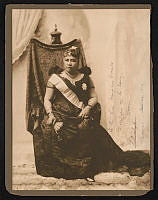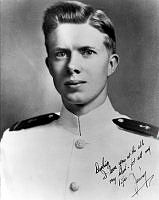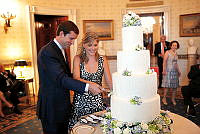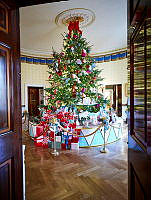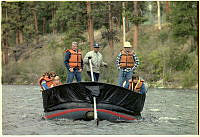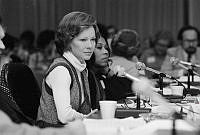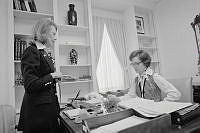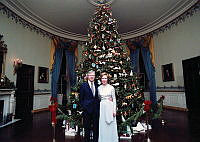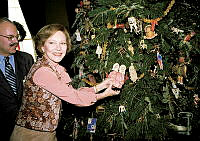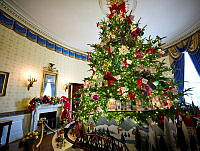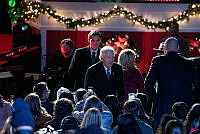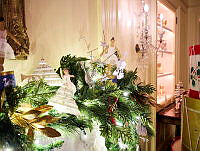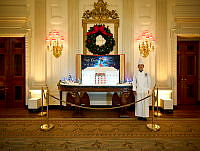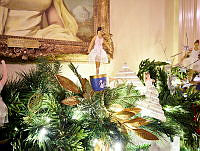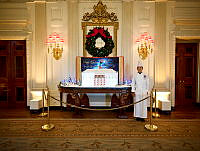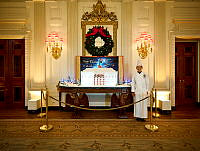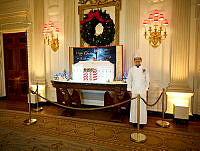Rubenstein Center Scholarship
The Office of the First Lady: The Evolution of the East Wing Staff
When First Lady Pat Nixon’s outgoing Chief of Staff and Press Secretary Constance Stuart sat for her White House exit interview in 1973, Stuart stated that “there isn’t a reader in America who really wants to know all the details of how this staff operates.”1 Since Stuart’s declaration, historians have become more interested in the role played by first ladies in the public life of the nation. Taking their name from the area of the White House in which they operate, the East Wing staff have become a key component of the institution of the modern presidency. Historically a largely female staff, the women of the East Wing have long been behind the staging of events at the White House, as well as facilitating and executing first lady projects throughout the twentieth century. Recent research into the evolution of the East Wing staff has sought to question how the Office of the First Lady came to exist as an official organizational entity within the broader executive staff structure. Who were the women of the East Wing staff? And how did the Office of the First Lady come to exist formally in the late 1970s? Such questions shed light on a lesser-known story of women working at the heart of the White House and enhance our understanding of the development of the first lady’s role.

This photograph shows East Wing Staff Director and Press Secretary Constance Cornell Stuart assisting First Lady Pat Nixon at her desk on the Second Floor of the White House on December 30, 1970.
White House Photo Office Collection, Richard M. Nixon Presidential Library and Museum/NARADuring Theodore Roosevelt’s presidency, Isabella Hagner was appointed as social secretary in 1901 to work under the direction of First Lady Edith Roosevelt. While this was a new addition to the White House staff, it was quite common for high-profile, affluent women in Washington, D.C. to employ female secretaries. Typically, these women were well-educated, well-connected, single young women who fit seamlessly into the elite networks within which they operated. They were Washington insiders who had the social and political knowledge necessary to thrive in their roles, although most left their positions once they married.

Portrait of Isabella Hagner, the first White House Social Secretary who started serving in 1901, from the collection of the Hagner Family.
Collection of the Hagner familyDuring Taft’s presidency, beginning in 1909, Hagner was replaced by Alice Blech. Blech already had experience as a government employee, having worked previously as an attaché at the Bureau of American Republics.2 Her appointment had been a competitive process, beating a number of other applicants to the position, and her role primarily consisted of stenographic duties under First Lady Helen Taft.3 Hagner consolidated the role she had carved out for herself when she returned during the Woodrow Wilson presidency, before being replaced by Edith Benham (later Benham Helm). The daughter of U.S. Naval Admiral Andrew E. K. Benham, she went on to serve a remarkable tenure as social secretary throughout the presidencies of Woodrow Wilson, Franklin D. Roosevelt, and Harry Truman. Testament to the social secretary’s proximity to presidential power, Benham traveled with the president and First Lady Edith Wilson to the Paris Peace Conference in 1919 at the end of the First World War. In 1930, Mrs. Benham Helm published a series of articles in Cosmopolitan Magazine about her experiences with the Wilsons at the Conference much to the delight of her later employer Eleanor Roosevelt, who wrote that it was “a great triumph to have written them, made them interesting and not said anything which was harmful!”4

This photograph shows Edith Benham Helm sitting at a desk with two male members of staff on the Second Floor of the White House in 1918.
White House Historical AssociationThe role of social secretary remained seemingly unchanged through the following presidencies, primarily assisting the incumbent first lady with personal administration and the staging of social events at the White House. Appointees to the role continued to be plucked from the higher socio-political echelons with Laura Harlan, daughter of Supreme Court Associate Justice John M. Harlan, serving under First Lady Florence Harding.5 Through the early twentieth century, the work of the social secretary was largely undertaken from the Second Floor of the Executive Mansion. In the Coolidge years, the Washington Post explained that the incumbent secretary Mary Randolph “has presided over the small office of Mrs. Coolidge at the Treasury end of the long corridor on the second floor of the White House with great efficiency and tact,” indicating that the first lady’s staffers still operated out of the first family’s quarters rather than having their own dedicated office space.6 Although the East Terrace was initially constructed during the renovations by Theodore Roosevelt to serve primarily as the main social entrance to the White House, the East Wing building was not erected as the permanent structure seen today until the Franklin D. Roosevelt’s presidency.
By the 1930s, first ladies began taking on additional staffers to assist with their expanding role as a public figure and patron, with Lou Hoover bringing in additional secretaries to the staff to assist with her involvement with the Girl Scouts. This expanded staffing situation led the press to refer to the first lady’s “secretariat,” recognizing for the first time an organization of women working under the direction of the first lady within the executive establishment, specifically for her.7 Moreover, one of the most famous first ladies to have occupied the White House, Eleanor Roosevelt, similarly brought in a large staff to assist in her expanding role, including the veteran Edith Benham Helm, as well as her long-time secretary and friend Malvina Thompson. Thompson worked as a secretary for Mrs. Roosevelt during the Al Smith Gubernatorial campaign of 1922 and traveled extensively with Mrs. Roosevelt across the country, assisting with her civic and political engagements as the wife of a prominent Democrat and the scion of an important American dynasty.8 Mrs. Roosevelt’s own growing role and recruitment of additional staffers occurred against the backdrop of the expansion of the presidential bureaucracy that took place under her husband’s administration: the Executive Office of the President was only just being established in 1939 as the infrastructure of the presidency was reshaped.9
Not only was Mrs. Roosevelt the longest serving first lady, but she is also widely recognized by historians as being the standard against which all other first ladies have since been measured due to her transformation of the public role of the first lady. While some contemporaries believed she should be more of a “traditional” first lady, Eleanor set a new course and standard. Her activism on behalf of African Americans, women, immigrants, and working-class Americans is unmatched and indeed, her example would be emulated by later first ladies in championing causes including women’s rights in the mid-twentieth century. And so, while the staffing of the first lady’s operations had evolved in a relatively informal manner, by the later decades of the first half of the twentieth century conventions had become entrenched relating to the profile of women recruited to serve the first lady. As the landscape of the presidential bureaucracy continued to develop, so did the role of the first lady and the position of her staffers within the executive establishment.

This photograph, taken on April 1, 1941, shows First Lady Eleanor Roosevelt sitting in front of a fireplace, accompanied by her staffers Malvina Thompson and Edith Helm at the White House in Washington, D.C.
Franklin D. Roosevelt Presidential Library & Museum/NARAAlthough the first lady’s staff had grown to include more than one secretary working under her direction and multiple clerical assistants by the mid-twentieth century, specialization of staff roles had not yet taken place. Bess Truman had the help of an additional secretary, Raethel Odum, who “shared with Mrs. Helm the responsibility of disseminating White House news of special interest to women.”10 Newspapers already referred to the first lady’s social secretary as her official spokesperson in their coverage, despite the fact that the role of press secretary had not yet been officially designated on the staff. During the Eisenhower years, Mary Jane McCaffree was interchangeably referred to as “Mrs. Eisenhower’s news secretary” and as the social secretary in coverage by the Washington Post.11 With the increasing demands for news coverage that came with the rise of mass media by the mid-twentieth century, the first lady’s staff adapted to meet the new demands on the office.

This photograph taken by Abbie Rowe on August 11, 1948, shows Social Secretary Reathel Odum working at her desk in the White House surrounded by papers, typewriters and telephones.
National Park Service, Abbie Rowe, Courtesy of Harry S. Truman Presidential Library and Museum/NARAThe Kennedy era marked a turning point for the first lady and for the East Wing staff. The glamorous, young, new First Lady Jacqueline Kennedy was, as journalist Helen Thomas remembered, “front page news every day.”12 As such, it became necessary for the East Wing to devote more of its organization towards handling the press. This resulted in the appointment of Press Secretary Pamela Turnure working under the direction of incumbent Social Secretary Letitia Baldridge, operating out of their dedicated office space in the East Wing. While many previous first ladies often supported charitable causes and their husband’s own domestic policy initiatives, the Kennedy administration’s activities consolidated the notion of a first lady project. Mrs. Kennedy’s restoration project, preserving Lafayette Square, conducting a televised tour of the White House, and establishing the White House Historical Association, was a landmark initiative which transformed the role of the first lady as a public figure. These projects also required a fully engaged staff in the East Wing to assist in the execution of these activities, and thus led to a widening scope for the staffers as they became more involved in projects beyond their traditional role as social organizers.
Staff structure and political development continued throughout the following administrations, with the unit growing as the public role of the first lady expanded and became increasingly political. Lady Bird Johnson passionately championed environmentalism in her beautification program, which found real political impact through the passage of the 1965 Highway Beautification Act, otherwise known as “Lady Bird’s Bill.” This project required recruitment of additional specialized staffers to the East Wing staff, with Sharon Francis brought over from the Department of the Interior to assist with beautification correspondence and planning. The Johnson years saw an increasing degree of professionalization more generally in the staff, with Liz Carpenter being the first former professional newspaperwoman appointed to the role of press secretary in the East Wing. In addition, the significance of new forms of mass media was clear with the appointment of Simone Poulain on the Johnson staff in the specific role of television and radio advisor on the press staff, further indicating greater specialization of the staff roles.

This photograph, taken by President Johnson’s official photographer Yoichi Okamoto on January 17, 1969, shows from left to right Press Secretary Liz Carpenter, First Lady Lady Bird Johnson, Social Secretary Bess Abell and Personal Secretary Ashton Gonella gathered for a staff meeting on the Second Floor of the White House.
Lyndon Baines Johnson Presidential Library and Museum/NARADuring Richard Nixon’s presidency, the unit professionalized further still with the addition of a director of press relations and a press coordinator, as well as the radio and television coordinator, all working under Constance Stuart as press secretary. The expanding Nixon staff even included a projects coordinator for a short period of time as the organizational structure was adapted to facilitate the increasing volume of activity undertaken by first ladies of this period. The Nixon era saw a real attempt on the part of the administration to bring more women into government roles, with Barbara Franklin appointed as a Staff Assistant to the President with the express aim of promoting the position of women in government work. At the same time though, the Nixon presidency was a period of particularly tense relations between the East and West Wing staffs. Chief of Staff H. R. Haldeman had a direct hand in appointing Constance Stuart to her position and attempted to keep a close eye on the activities of the East Wing staff, sending extensive unsolicited feedback to the women on their activities on a regular basis. Eventually, to avoid staff confrontation, during Gerald Ford’s presidency strategies were drawn up between the East and West Wings to model the East Wing staff as an operational counterpart to the West Wing.
In the aftermath of the Watergate scandal, Betty Ford inherited the East Wing organization and continued to operate within this framework for a short period of time, before making her own changes to the staff. Mrs. Ford acted as her own staff director, taking a more active hand in the running of her own staff, and reorganizing the East Wing offices to allow herself space for an office of her own amongst her team. Moreover, Ford continued to promote professional women with careers in the media and government to her staff. Press Secretary Sheila Weidenfeld had been a successful television producer, and Social Secretary Maria Downs served as a staff assistant on the Goldwater for President Committee in 1964, before undertaking roles variously at the Republican National Committee and as the executive director at the Women’s National Press Club. More than a social operation then, by this point the first lady ran a well-oiled political machine, staffed by professional career women with specific skills and experiences. As the East Wing staff began to push the boundaries of their traditional duties, with Mrs. Ford and her staffers becoming increasingly vocal in their support of the Equal Rights Amendment as the contemporary feminist movement of the 1970s came to dominate public discourse, the West Wing staff sought to better coordinate to make sure that the two entities acted as one unified body. Suggesting a system for coordinating the two wings as organizational counterparts, presidential aide Bradley H. Patterson Jr. reminded both parties that "the East Wing, the West Wing and the EOB are a single staff family."13

This digitized document from the Ford era is undated but shows the potential plan for the layout of the East Wing offices, including an office for First Lady Betty Ford. The document is evidence of the planning that went into the rearrangement of the East Wing staff offices during the Ford era.
Gerald R. Ford Presidential Library/NARAThese organizational changes within the East Wing staff came to a head during Jimmy Carter’s presidency. By this point, the basic blueprint for the contemporary staff was largely established and these arrangements were finally formalized by the provision of assistance for the spouse of the president through the 1978 White House Personnel Authorization Act. Together with Rosalynn Carter’s reorganization of the staff, the organizational entity as we recognize it in the twenty-first century was formalized, consolidating decades of convention.14 Although the first lady’s staff has been evolving since 1901 and the appointment of Isabelle Hagner, the administrations between 1961 and 1976 through the tenures of Jacqueline Kennedy, Lady Bird Johnson, Pat Nixon and Betty Ford saw a constant trajectory of intense staff evolution, specialization, and professionalization which produced the modern East Wing staff.
Not only does this research tell the stories of key women who made the increasingly public activity of first ladies possible in the mid-twentieth century, but many of these women were themselves feminist-oriented thinkers. As the contemporary women's movement of the 1960s grew, high profile East Wing women such as Johnson Press Secretary Liz Carpenter advocated for improvements for the position of women in public life from their position behind-the-scenes but close to the power of the presidency. Into the 1970s, Betty Ford Rosalynn Carter and their staffs lobbied for the passage of the Equal Rights Amendment which prohibited sex-based discrimination. The history of the growth of the East Wing staff is also, therefore, intertwined with the story of women in political life more broadly and thus in some ways acts as a very specific microcosm reflecting the wider social changes related to gender and women’s status in the mid-twentieth century. Incorporating an understanding of how the women of the East Wing staff contributed to the development of the Office of the First Lady is arguably an essential addition to narratives of modern presidential history for a more complete picture of how women operated within the Executive Office of the President. And so, whilst Constance Stuart may have felt that there was limited public interest in how the East Wing staff operated when she left the White House in 1973, uncovering the story of how the first lady’s staff operated and evolved reveals significant new insight into experiences of women working within the modern presidency.
About the Author
Elizabeth Rees served as a 2023-2024 Research Fellow in the David M. Rubenstein National Center for White House History. She is a DPhil candidate at the University of Oxford's Rothermere American Institute. She received her MA in U.S. Studies from University College London in 2019, and her BA in English Literature and History from the University of Exeter in 2018. Elizabeth's project investigates the emergence of the modern East Wing staff and Office of First Lady between the administrations of 1961-1976. In this transformative era, the East Wing staff developed into a professionalized unit and emerged as an organizational counterpart to the West Wing. Likewise, her research shows how the East Wing staff acted as a microcosm for the contemporary socio-political changes relating to gender, women in work, and the emerging feminist movement. She has also taught on classes related to race and civil rights, as well as the Ronald Reagan presidency and the AIDS crisis.













